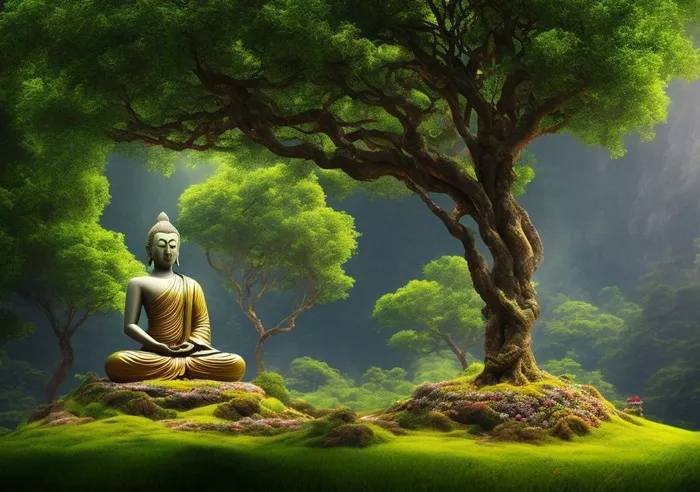Bronze Buddha statues are a beautiful and meaningful part of Buddhist culture. They are not just decorative objects but also powerful symbols of faith and wisdom. Many people place these statues in their homes, temples, or gardens for spiritual inspiration. This article will explore the history, symbolism, and practical tips on how to care for bronze Buddha statues. Understanding these aspects helps deepen respect and connection to Buddhist teachings.
History of Bronze Buddha Statues
Early Origins of Buddha Statues
The earliest Buddha statues appeared about 2,000 years ago. At first, Buddhist art did not show the Buddha in human form. Instead, symbols like footprints, a lotus flower, or an empty throne were used. Later, in places like India and Southeast Asia, artists began creating statues showing the Buddha’s physical form. Bronze became a popular material for these statues because it is strong and long-lasting.
Development of Bronze Casting
Bronze is an alloy made mainly from copper and tin. The technique of bronze casting is an ancient craft. It requires melting metal and pouring it into molds shaped like the statue. This method allowed artisans to create detailed and durable Buddha statues. Over centuries, bronze Buddha statues spread across Asia, including countries like China, Thailand, Japan, and Tibet.
Significance in Different Cultures
Each region added its own style to bronze Buddha statues. For example, Thai bronze statues often have slim and graceful shapes. Chinese bronze Buddhas may show more intricate robes and facial expressions. Tibetan statues are richly decorated and often include sacred symbols. Despite differences, all bronze Buddha statues share the purpose of inspiring mindfulness and compassion.
Symbolism of Bronze Buddha Statues
The Buddha’s Postures and Mudras
Every bronze Buddha statue has meaning based on the posture and hand gestures (called mudras). For example:
- Dhyana Mudra: Hands resting in the lap, symbolizing meditation and inner peace.
- Bhumisparsha Mudra: Right hand touching the ground, representing the moment of enlightenment.
- Abhaya Mudra: Raised right hand, symbolizing protection and fearlessness.
Knowing the meaning of these mudras helps people connect more deeply with the teachings represented by the statue.
Material Symbolism: Why Bronze?
Bronze itself carries symbolic meaning. Because it is made by combining different metals, bronze represents harmony and unity. The durability of bronze reflects the lasting wisdom of the Buddha’s teachings. Bronze statues age gracefully, developing a natural patina that many believers find beautiful and sacred.
Common Buddha Statues Types
You can learn more about the buddha statues types to recognize different forms and meanings. These include seated, standing, reclining, and walking Buddhas. Each type tells a different story about the Buddha’s life and spiritual qualities.
How to Care for Bronze Buddha Statues
Cleaning Bronze Buddha Statues
Proper care helps keep your bronze Buddha statue looking beautiful for many years. When cleaning:
- Use a soft cloth or brush to gently remove dust and dirt.
- Avoid harsh chemicals or abrasive materials that can damage the bronze surface.
- If needed, clean with mild soap and water, then dry completely.
Regular gentle cleaning preserves the statue’s natural shine and prevents corrosion.
Protecting from Weather
Bronze statues placed outdoors can be affected by rain, sunlight, and pollution. To protect them:
- Consider applying a thin layer of wax made for bronze to create a protective barrier.
- Place the statue in a sheltered location if possible, avoiding direct exposure to harsh elements.
- Check the statue regularly for signs of green or white spots, which indicate corrosion.
Handling and Placement Tips
When moving or placing your bronze Buddha statue:
- Handle it with clean hands or gloves to avoid oils transferring to the bronze.
- Place the statue on a stable and clean surface.
- Choose a respectful and peaceful spot, often facing east or in a meditation area.
These practices honor the statue and enhance its spiritual presence.
Understanding the Deeper Meaning of Buddha Statues
More Than Just Art
Buddha statues are not only beautiful art objects. They serve as reminders of the Buddha’s teachings on compassion, wisdom, and the path to enlightenment. A bronze Buddha statue can inspire calmness and mindfulness in daily life.
How to Use Buddha Statues in Practice
Many Buddhists place statues on altars to support meditation and prayer. When you see the statue, you can reflect on the qualities of the Buddha. This practice helps develop patience, kindness, and inner peace.
Learning the Buddha Statue Meaning
Understanding the buddha statue meaning enriches your connection to the statue. Each statue tells a story and teaches a lesson. Whether it is the peaceful face, the flowing robes, or the special hand gesture, every detail points to spiritual truths.
Conclusion
Bronze Buddha statues carry a rich history and deep symbolism in Buddhism. They are more than simple objects — they represent the Buddha’s enlightened qualities and help guide followers on the spiritual path. By learning how to care for these statues properly, you preserve their beauty and sacredness for years to come. Whether placed in a temple or your home, a bronze Buddha statue is a meaningful treasure that brings peace and inspiration.

